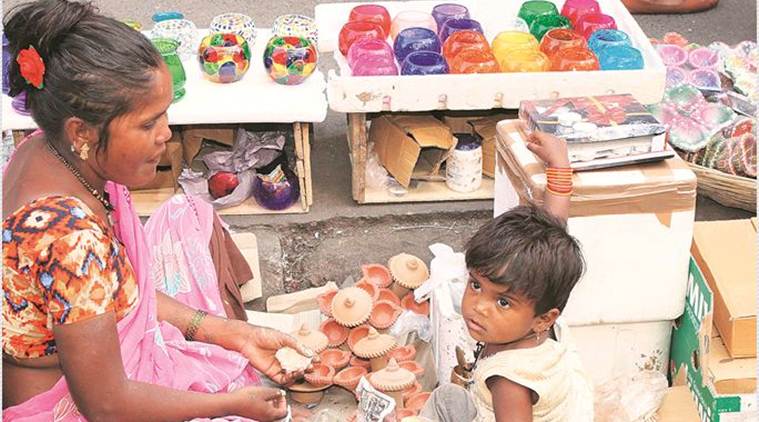 The families have made the footpaths of Thane their homes. (Express Photo by Deepak Joshi)
The families have made the footpaths of Thane their homes. (Express Photo by Deepak Joshi)
“Diwali is coming,” little Avantika says nonchalantly as she continues painting earthen diyas, along with her mother Vandana. The mother-daughter duo is part of a group of farmers and farm labourers who have made the footpaths of Thane their makeshift homes.
While they are selling diyas to the locals this Diwali, for the bunch hailing from the drought-hit village of Wakhari near Pandharpur, the poor condition back home has forced them to travel over 350 km in search of livelihood.
Most of the roadside vendors in Thane are villagers from in and around Pandharpur. The Kale family from Ujani has been living on the streets near Thane station since Dussehra. “We will stay till the day of Lakshmi puja, as the trains to go back home are available only on specific days,” said Manchali Kale (36), who has put up a small stall near the station. “We have borrowed money from money-lenders and we need to earn enough so that we can survive at least for a few months,” she said.
Her husband, Rajiv (40) said: “We used to have two acres of farmland. But that is all gone now while paying off the loans, as we were not able to cultivate any crop owing to the drought. But we need food to survive and clothes to cover up… We are not nomads, but are forced to live like them…This has become our reality now.”
The Kales travel to Pune for Ganesh Chaturthi, Ahmednagar for Navratri, and to Thane for Diwali. “We sell anything and everything that is available in wholesale markets and that can earn us some money,” he adds.
The Kales are not alone. Bandu Chavhan and his wife Anita have been coming to Thane for the past four years. This was before their daughter Pinky was born. Today, the toddler runs out on the streets and her mother has to keep an eye out for her while haggling with her customers.
“For most of the year, we work as helpers in someone’s farm. But during festivals, there is no work,” Bandu (29) said. Anita said: “We would rather celebrate festivals here earning some money, instead of sitting in the house without enough money to light even one diya.”
The farmers and labourers travel to the city using the state transport buses or trains and make beelines at Crawford or Dharavi markets from where they purchase raw material, like colours, patterned papers and diyas. The families then work on the footpaths and sell their wares there or at traffic signals. The work is strenuous. So, the family members work in shifts, with the men generally sleeping during the afternoon under any shade they manage to acquire. Pandharpur and the nearby areas have faced drought-like situation even this year.
“Around five years ago, my uncle hung himself as he couldn’t repay his loans. We struggled to arrange for funds to perform his last rites. There was no money. Since then, we have been taking every opportunity to earn money. The rain gods have not been kind of us,” says Vandana from Pandharpur, who has a three-year-old daughter.
Adya Chavhan (54), a vendor from Wakhari village, said: “There is no water to drink right now. We have to walk for miles. God knows what will happen once the summer approaches. There has been no rain, which means we can’t grow anything. We have to find other options to repay our loans, or the heads of the families will have to start looking for ropes to hang themselves. In order to avoid that, we come here to sell these diyas,” she said.
Some of the villagers were hopeful about better water supply from the proposed Ujani irrigation project — it did not take off. Their demands to get water from Tembhu irrigation project, in neighbouring Sangli district, have fallen on deaf ears. “We have learnt from the past. No one comes to help. While the locals here waste water, back home, we treat each drop as something more expensive than blood,” Rajiv said.
Agriculture in Maharashtra is heavily dependent on monsoon, as only 18 per cent of the state has access to irrigation facilities. In an effort to boost agriculture in the rain-dependent areas, the state government has launched a scheme under which some villages would avail of special subsidy for soil treatment, introduction of special drought-resilient crops and micro-irrigation schemes, among other benefits. But all this makes little sense for the temporary street-dwellers from Pandharpur.
“We are not robbing anyone. If anything, we are making the festivals more colourful for those who are more fortunate than us. One day fate will make our festivals colourful as well. Hopefully, me and my family members would be alive to see that day,” Madhavi Kale, Rajiv’s niece said.